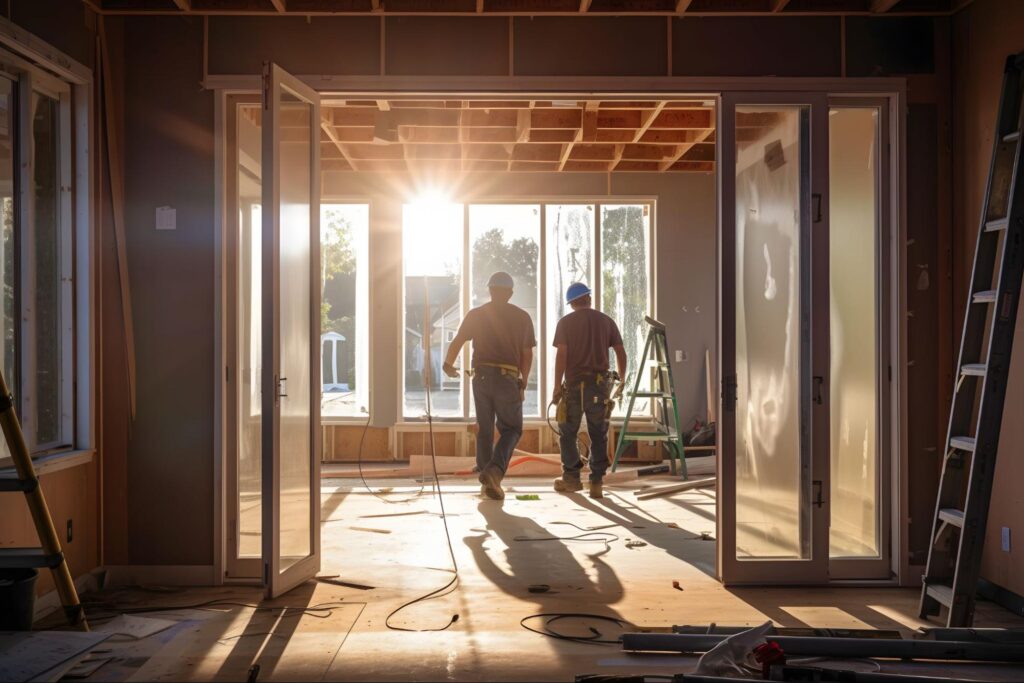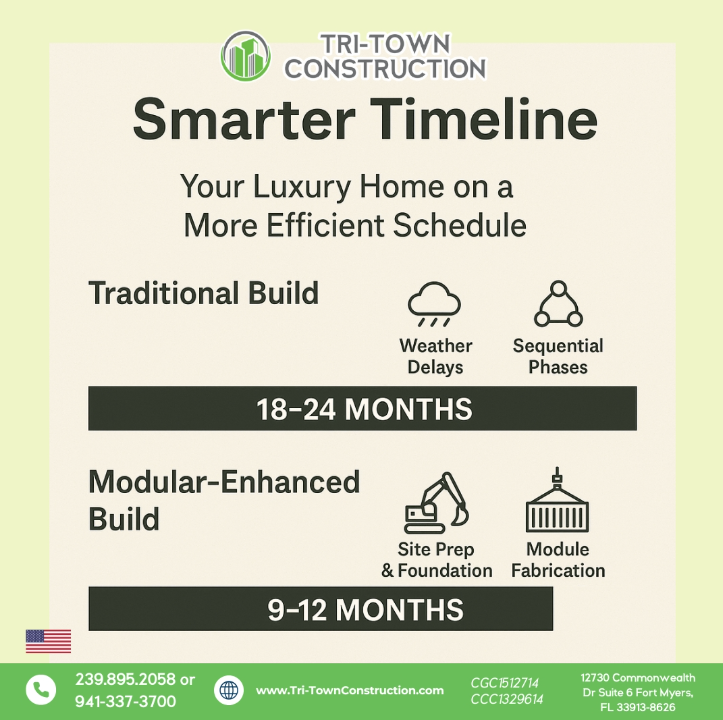The Best Time To Build A Home In Florida
The best time to build a home in Florida is fall and winter, when cooler temperatures, lower humidity, and fewer storms allow smoother progress, faster permits, and greater contractor availability compared to spring or summer.
Seasonal Guide to Building a Florida Home Without Delays
Florida’s climate directly impacts construction, making timing essential.
Fall and winter, from October to February, are the most favorable with drier weather, fewer delays, and faster permits.
Spring, from March to May, offers steady conditions but higher costs due to rising demand.
Summer, June to September, brings the greatest challenges, with daily storms, humidity, and hurricane risks that often cause delays and material damage.
Key factors to consider before building:
- Fall and winter deliver the most predictable progress.
- Spring works but costs more due to higher demand.
- Summer increases risks from weather and scheduling conflicts.
- Planning 6–12 months in advance ensures access to top contractors.
Seasonal timing is only part of the equation.
How you plan and what construction methods you choose will decide your success, so keep reading to discover strategies that protect your investment from Florida’s toughest conditions.
Why Florida Weather Makes or Breaks Your Build

When it comes to building a home in Florida, weather isn’t just a background factor, it’s a central force that can shape your schedule, your budget, and even your home’s long-term durability.
Knowing how to navigate the climate here can be the difference between smooth progress and weeks of frustrating delays.
Dry vs Rainy: Florida’s Two-Season Forecast
Florida operates on two dominant seasons: dry season from November to April and rainy season, which runs from June through November.
The dry season offers lower humidity, cooler temperatures, and far fewer storms, all ideal for construction.
On the other hand, the rainy season is marked by daily thunderstorms and hurricane activity that can halt work, flood job sites, and delay inspections.
Heat, Humidity, and Their Impact on Construction
High temperatures and humidity don’t just slow crews down, they directly impact material performance. Concrete poured during hot weather can cure too quickly, leading to cracks.
Wood framing may swell or warp, while paint, adhesives, and stucco struggle to set properly in the wet, sticky air.
This environment raises valid concerns for any homeowner:
- Will materials get moldy if they’re exposed to rain?
- What if a hurricane hits while the house is half-built?
- How long do weather delays actually last?
Storm Risk During Construction
Starting a build in the heart of hurricane season means accepting a higher level of risk.
Open-frame structures are especially vulnerable, and even if your home isn’t damaged directly, supply chains and labor availability can be severely impacted by regional storms.
Understanding Florida’s climate is the foundation of a successful build.
Next, we’ll explore the seasons in more detail and break down when it’s actually smartest to start building.
Also Read → ICF vs Wood-Frame Costs in Florida: What to Expect
When to Build in Florida for the Smoothest Progress
Timing your home build in Florida can save you weeks of delays, reduce material risks, and open up access to better contractors.
But each season carries its own set of advantages and trade-offs. Understanding how they compare can help you plan more effectively.
1. Fall and Winter: Florida’s Prime Building Seasons
From October to February, construction conditions are at their most favorable. These months bring cooler temperatures and a break from daily storms.
- Lower humidity creates stable working conditions for framing, roofing, and finishes.
- Fewer weather delays help projects move along without frequent rescheduling.
- Permit offices are less backed up, speeding up administrative steps.
- Contractor schedules are more flexible during off-peak months.
- Building now avoids the peak of hurricane season and rising spring costs.
Fall and winter align with the dry season, offering more control over your timeline and build quality.
2. Spring: Stable Weather with Rising Demand
Spring delivers mild, workable weather, but it also signals the return of demand. March to May can be a solid build window if schedules and budgets are prepared early.
- Weather stays relatively dry and predictable, which supports uninterrupted construction.
- Materials perform well in this season, especially exterior finishes and concrete.
- Contractor availability begins to tighten as projects ramp up.
- Material and labor prices may rise due to higher demand.
- Permit offices can become busier, especially in coastal areas.
Spring is still a workable season but requires early planning to stay ahead of scheduling and cost increases.
3. Summer: The Most Challenging Time of Year
June through September is Florida’s rainy season and the peak of hurricane risk. Weather volatility makes this the hardest time to build.
- Daily thunderstorms often halt afternoon work and slow inspections.
- High heat and humidity increase the risk of material warping and curing issues.
- Hurricane threats can stall entire phases or damage partially built structures.
- Labor and trades are often booked months out.
- Moisture exposure may lead to quality concerns if delays stretch out.
Building in summer demands more lead time, flexible scheduling, and additional precautions.
Next, we’ll show you how to turn seasonal awareness into a weather-smart build plan that protects your time and investment.
Helpful Resource → Florida Hurricane Building Codes Explained
How to Plan Ahead for Fewer Weather Disruptions

The smoother your build runs, the more likely it is to stay on time and on budget. In Florida, that often comes down to how early and how well you plan.
Getting ahead of seasonal bottlenecks, permit delays, and material issues can make all the difference.
1. Start Early and Secure Your Team
Contractors, subcontractors, and inspectors tend to book up quickly, especially in spring and summer.
Planning your build six to twelve months ahead gives you access to more scheduling options and helps avoid last-minute scrambling during peak demand.
2. Submit Permits Before the Rush
Fall and winter tend to be less congested for city and county permit offices.
Submitting during these months can shorten the wait and help you avoid delays that commonly happen during hurricane season, when approval timelines often slow due to staffing or shifting municipal priorities.
3. Choose Materials That Withstand Florida’s Climate
Moisture and heat are year-round factors in Florida, so using materials that hold up in these conditions is important.
Pressure-treated lumber, impact-rated windows, and mold-resistant drywall all perform well when rain and humidity are high.
For summer projects, scheduling concrete work early in the day helps manage heat-related curing issues.
4. Build When It’s Less Disruptive
Some homeowners choose to begin construction after tourist season, when traffic and neighborhood disruptions are lower.
Starting in the fall also helps some property owners avoid changes in annual tax assessments by completing certain stages of the build before the calendar year resets.
Planning with Florida’s climate in mind helps reduce uncertainty.
View this post on Instagram
When timelines, permits, and materials are handled early, the build itself becomes far less reactive and much more predictable.
With the right planning, a traditional build can stay on track even in Florida’s challenging climate.
Still, some homeowners look for additional certainty, which is where modular construction becomes an option worth considering alongside more conventional approaches.
How Modular Homes Beat the Florida Weather Clock
Building in Florida means working around the weather.
Modular construction offers a way to stay on schedule without waiting on clear skies. It’s fast, controlled, and designed for climates like ours.
1. Built Off-Site, Away from the Storms
Modular homes are constructed in climate-controlled facilities, so the build itself isn’t exposed to rain, wind, or humidity.
While site prep happens on location, the home’s structure is protected and assembled off-site.
Once ready, it’s delivered and installed in a matter of days. This approach shortens timelines and avoids issues like moisture damage, warping, or delays caused by daily storms.
2. A Reliable Option During Rainy Season
Traditional builds can stretch out for months during Florida’s wet season. Modular homes, by contrast, keep things moving.
Most of the work is done before the structure even hits your lot, reducing delays from bad weather or limited trade availability.
3. Built Strong for Storm Zones
Many modular builders in Florida combine this method with ICF wall systems, offering greater resistance to water intrusion and wind impact.
It’s a smart match for hurricane-prone areas where code compliance and durability matter.
4. Not Just Budget Builds Anymore
Today’s modular homes offer custom finishes, open layouts, and storm-rated features.
They’re becoming a go-to choice for homeowners who want quality and speed without compromise, especially in a climate that doesn’t always cooperate.
Helpful Resource → How Long Does It Take to Build a Modular Home in Florida?
Final Thoughts: Weather-Smart Building in Florida

Building in Florida means adapting to the climate while staying focused on quality and timelines.
Fall and winter often bring the smoothest progress, spring remains workable with some added demand, and summer carries the most challenges.
Careful planning, permit timing, and the right materials go a long way in reducing weather-related risks, while modular homes can add another layer of certainty.
At Tri-Town Construction, we know Florida’s conditions inside and out.
Whether it’s storm season or the height of summer, our team delivers and builds that stand strong against the elements.
With a focus on integrity, craftsmanship, and community, we make sure your home gets built the right way, no matter the forecast.


